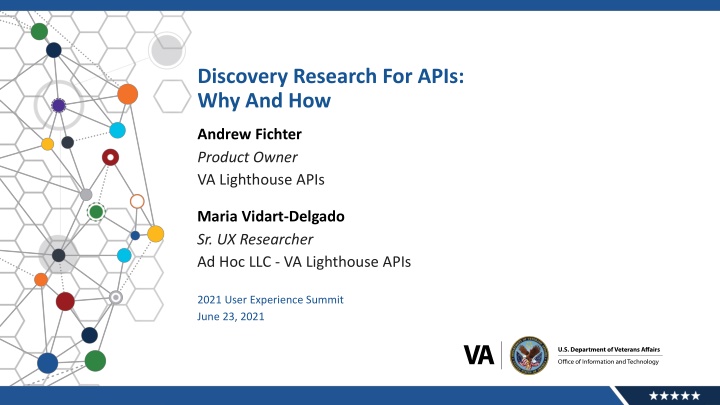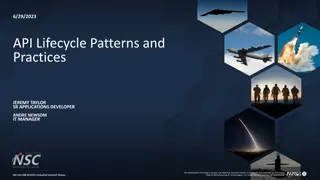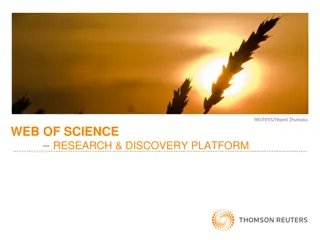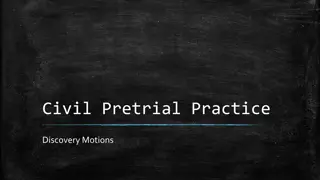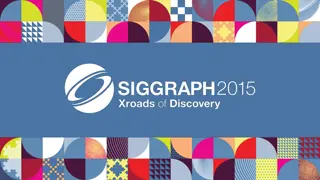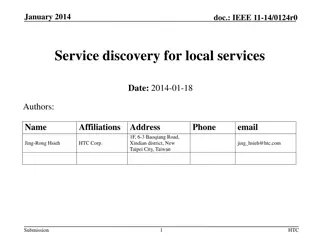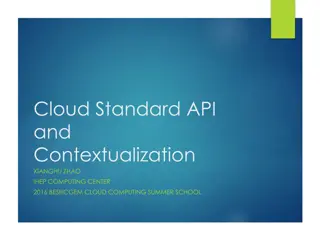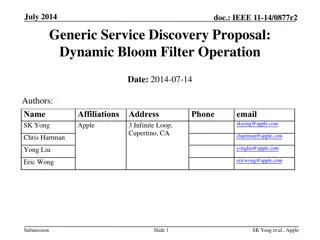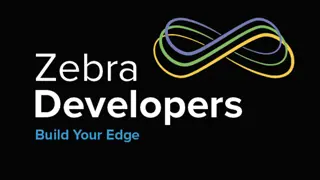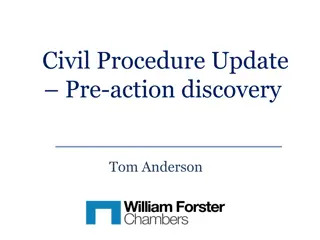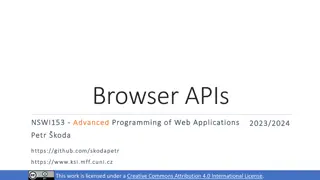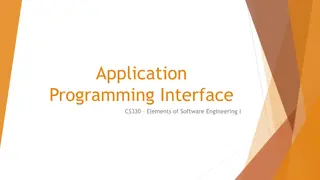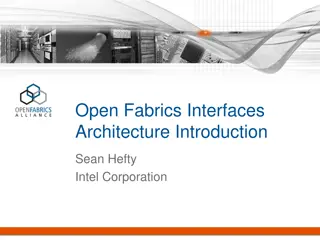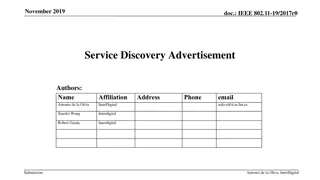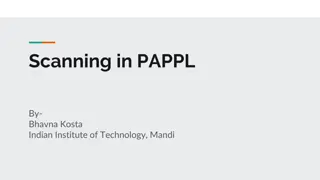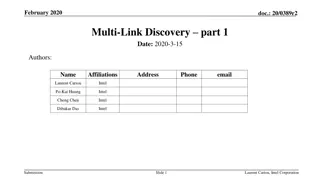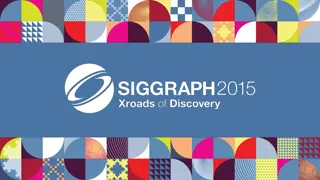Discovery Research for APIs: Why and How
In this presentation by Andrew Fichter and Maria Vidart-Delgado, the focus is on understanding the importance of discovery research for APIs, specifically looking at VA Lighthouse APIs. The session covers the definition of VA Lighthouse APIs, their impact, and how they can solve various problems faced by the Department of Veterans Affairs. The discussion includes methods, key takeaways, and real-world examples to illustrate the benefits of utilizing APIs in streamlining processes for accessing critical benefits and services.
Download Presentation

Please find below an Image/Link to download the presentation.
The content on the website is provided AS IS for your information and personal use only. It may not be sold, licensed, or shared on other websites without obtaining consent from the author.If you encounter any issues during the download, it is possible that the publisher has removed the file from their server.
You are allowed to download the files provided on this website for personal or commercial use, subject to the condition that they are used lawfully. All files are the property of their respective owners.
The content on the website is provided AS IS for your information and personal use only. It may not be sold, licensed, or shared on other websites without obtaining consent from the author.
E N D
Presentation Transcript
Discovery Research For APIs: Why And How Andrew Fichter Product Owner VA Lighthouse APIs Maria Vidart-Delgado Sr. UX Researcher Ad Hoc LLC - VA Lighthouse APIs 2021 User Experience Summit June 23, 2021
Agenda What are VA Lighthouse APIs? Impact Why discovery for APIs? How to? (an example) Methods Questions Learnings Key Takeaways 2 FOR INTERNAL USE ONLY Office of Information and Technology
APIs are digital pipes that connect UIs to backend systems. 4 FOR INTERNAL USE ONLY Office of Information and Technology
APIs can solve many problems at VA The VA Lighthouse API platform offers a portfolio of public-facing services, allowing third parties to seamlessly and securely plug in to VA data much like plugging an appliance into a wall socket. FOR INTERNAL USE ONLY Office of Information and Technology 5
APIs help solve problems at VA The Department of Veterans Affairs offers many critical benefits and services to an enormous population of Veterans. But the process to discover, apply for, and obtain access to those benefits and services is often time-consuming, difficult, and slow. VA Lighthouse APIs help to address this. Veterans applying for VA benefits wait weeks (often months) for an award decision, while relying on paper mail correspondence to navigate the application process. Until recently, Veteran benefit claims applications could not be submitted digitally to VA. FOR INTERNAL USE ONLY Office of Information and Technology 6
Who integrates with VA Lighthouse Benefits and Appeals APIs? VA.gov Third party vendors that offer specialized software for Veteran Service Organizations (VSOs) Veteran Law Offices County VSOs VSOs assist Veterans with their claims. 7 FOR INTERNAL USE ONLY Office of Information and Technology
Impact 8
Impact indicators 25% In 2021, a self-service form was launched on VA.gov (and powered by a new API), enabling Veterans to digitally submit a specific Appeals form for the first time. Almost 25% of all submissions of this form now come through the API. 9 FOR INTERNAL USE ONLY Office of Information and Technology
Impact indicators continued 55,000 In April 2021, VSOs digitally submitted more than 55,000 claims packets to VA, and this number has been climbing steadily since the API that enables this was launched. 10 FOR INTERNAL USE ONLY Office of Information and Technology
UX for APIs 12 FOR INTERNAL USE ONLY Office of Information and Technology
UX for APIs Continued 13 FOR INTERNAL USE ONLY Office of Information and Technology
Differences between UX Phases Discovery Other UX Phases Geared to end-users Understand processes and contexts of government services Define problems (policy versus technical) Geared to API users Understand users workflows and information needs Assess whether APIs are usable FOR INTERNAL USE ONLY Office of Information and Technology 14
Why Discovery research for APIs? (1) Ensure the API solves the right problem. 15 FOR INTERNAL USE ONLY Office of Information and Technology
Why Discovery research for APIs? (2) Ensure the API solves the right problem. If it doesn t, developers won t know what to build with it. 16 FOR INTERNAL USE ONLY Office of Information and Technology
Why Discovery research for APIs? (3) Ensure the API solves the right problem. If it doesn t, developers won t know what to build with it. If developers don t know what to build with it, you can t UX your way to adoption. 17 FOR INTERNAL USE ONLY Office of Information and Technology
How to? An Example Methods, Questions, Learnings 18
An Ethnographic Approach An ethnographic approach to understand the benefits and appeals application and adjudication process at VA. 19 FOR INTERNAL USE ONLY Office of Information and Technology
An Ethnographic Approach Continued An ethnographic approach to understand the benefits and appeals application and adjudication process at VA. Ethnographic approach equals Systems thinking: How systems are set up? To what end? What s their organizing principle? 20 FOR INTERNAL USE ONLY Office of Information and Technology
Ethnographic Methods (1) Over 65 interviews with VSOs, Attorneys, Claims Agents, VA staff and SMEs located all over the country. 21 FOR INTERNAL USE ONLY Office of Information and Technology
Ethnographic Methods (2) Over 65 interviews with VSOs, Attorneys, Claims Agents, VA staff and SMEs located all over the country. Remote qualitative interviews, remote contextual inquiries, and collaborative process mapping exercises. 22 FOR INTERNAL USE ONLY Office of Information and Technology
Ethnographic Methods (3) Over 65 interviews with VSOs, Attorneys, Claims Agents, VA staff and SMEs located all over the country. Remote qualitative interviews, remote contextual inquiries, and collaborative process mapping exercises. Focused on understanding information needs, pain points and points of confusion. 23 FOR INTERNAL USE ONLY Office of Information and Technology
Example of Ethnographic Questions (1) Are there gaps between codified processes and practices on the ground? 24 FOR INTERNAL USE ONLY Office of Information and Technology
Example of Ethnographic Questions (2) Are there gaps between codified processes and practices on the ground? Are there differences in how individuals involved interpret the process? 25 FOR INTERNAL USE ONLY Office of Information and Technology
Example of Ethnographic Questions (3) Are there gaps between codified processes and practices on the ground? Are there differences in how individuals involved interpret the process? What are the different goals that individuals are trying to achieve? 26 FOR INTERNAL USE ONLY Office of Information and Technology
Example of Ethnographic Questions (4) Are there gaps between codified processes and practices on the ground? Are there differences in how individuals involved interpret the process? What are the different goals that individuals are trying to achieve? What is a benefit claim or appeal and according to whom? 27 FOR INTERNAL USE ONLY Office of Information and Technology
Learnings (1) For benefits and appeals, we learned that: Veterans, VSOs, Lawyers and Claims Assistants are looking for confirmation of receipt when they submit. 28 FOR INTERNAL USE ONLY Office of Information and Technology
Learnings (2) For benefits and appeals, we learned that: Veterans, VSOs, Lawyers and Claims Assistants are looking for confirmation of receipt when they submit. BUT...They don t always get the information they need. So they end up submitting duplicates. 29 FOR INTERNAL USE ONLY Office of Information and Technology
Learnings (3) For benefits and appeals, we learned that: Veterans, VSOs, Lawyers and Claims Assistants are looking for confirmation of receipt when they submit. BUT...They don t always get the information they need. So they end up submitting duplicates. WHICH backlog processing systems and delay the review process, causing stress and anxiety for claimants. 30 FOR INTERNAL USE ONLY Office of Information and Technology
Data Abstraction Maps 31 FOR INTERNAL USE ONLY Office of Information and Technology
Solutions We mapped actions taken and by whom, systems of record used, data reviewed and mistakes encountered. We have used these maps to architect the APIs and the validation logic. We re working on informative status endpoints for representatives, that are also legally compliant. 32 FOR INTERNAL USE ONLY Office of Information and Technology
Takeaways API usability entails having the right API functionality Ethnographic approaches are powerful to understand complex service systems and how digital solutions interact with them. Ethnographic questions, and their emphasis on understanding practices on the ground, lend to understanding how individuals interact with a system, and the information they need from an API. 34 FOR INTERNAL USE ONLY Office of Information and Technology
We don't have the time to help all the Veterans. And, you know, like I said, 10 people helping 50,000 Veterans is almost untenable. You can't do it. (...) Meanwhile, we're fighting budgets at the county. Some of the things that I see that can help us is being able to process claims more efficiently. That's why I'm very interested in all these API type solutions County VSO 35 FOR INTERNAL USE ONLY Office of Information and Technology
QUESTIONS? 36
